Chair yoga offers simple yet effective poses to help you unwind at your desk. Try the Seated Cat-Cow Stretch to release spinal tension, or the Chair Twist to improve flexibility. Neck and Shoulder Release exercises can alleviate upper body strain, while Seated Forward Folds target your back and hamstrings. Don't forget your lower body with Leg Extensions and Ankle Rotations. The Seated Mountain Pose improves posture, and Chair Pigeon Pose stretches hips and glutes. Finally, Wrist and Finger Stretches combat keyboard fatigue. These poses can easily fit into your workday routine, offering quick relief and promoting overall well-being. Discover how these gentle movements can transform your office experience.
Key Takeaways
- Seated Cat-Cow Stretch relieves tension in the spine and neck, improving posture and flexibility for office workers.
- Chair Twist offers spinal relief, improves flexibility, and aids digestion after prolonged desk work.
- Neck and Shoulder Release exercises, including neck rolls and shoulder shrugs, loosen tight muscles from desk-induced tension.
- Leg Extensions and Ankle Rotations alleviate discomfort from restless legs and stiff ankles while improving circulation.
- Wrist and Finger Stretches help relieve tension from keyboard and mouse use through various hand and wrist exercises.
Seated Cat-Cow Stretch
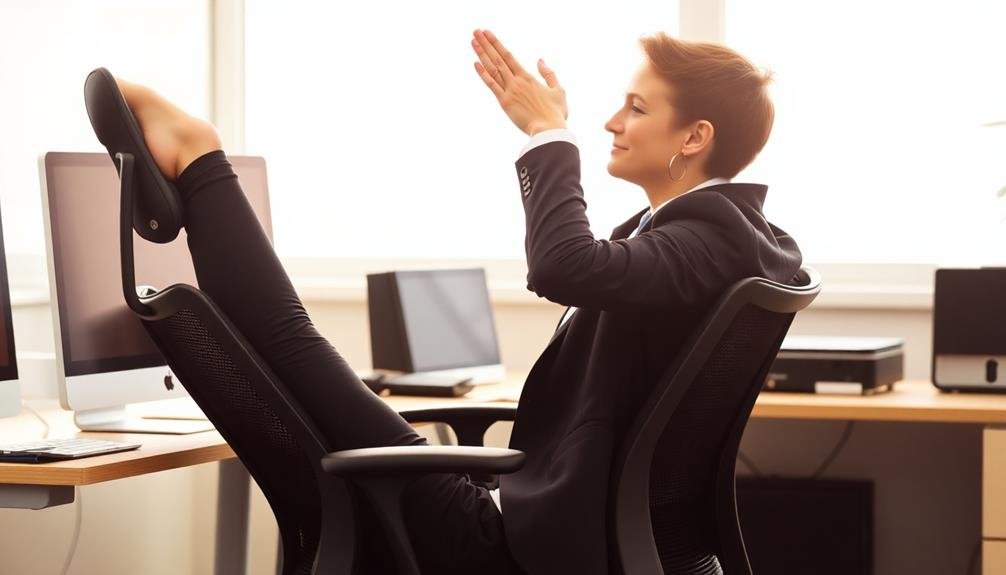
While sitting in your office chair, the seated cat-cow stretch offers a gentle way to release tension in your spine and neck.
Begin by sitting up straight with your feet flat on the floor and your hands resting on your knees. As you inhale, arch your back, push your chest forward, and lift your chin towards the ceiling. This is the "cow" position. Hold for a few seconds, feeling the stretch in your chest and abdomen.
Next, exhale slowly as you round your spine, tucking your chin to your chest and pulling your navel towards your spine. This is the "cat" position. Hold this pose briefly, focusing on the stretch in your upper back.
Repeat this sequence 5-10 times, moving smoothly between the two positions with your breath.
The seated cat-cow stretch helps improve posture, increases spinal flexibility, and relieves tension in your neck and shoulders.
It's particularly beneficial for office workers who spend long hours sitting at a desk. You can perform this stretch discreetly at your workstation, making it an ideal exercise to incorporate into your daily routine.
Remember to move slowly and gently, never pushing beyond your comfort level.
Chair Twist for Spinal Relief
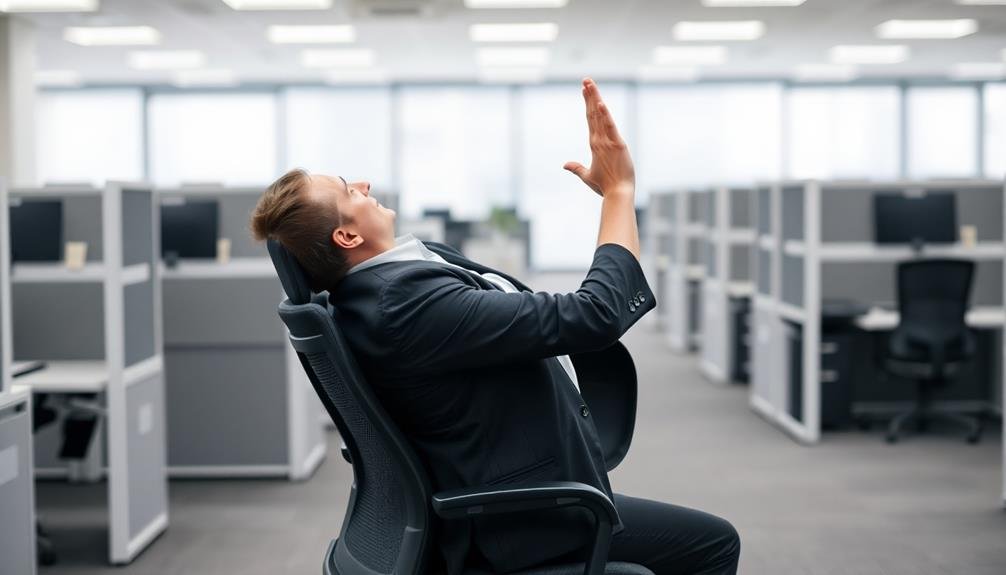
The Chair Twist offers welcome relief for your spine after hours of desk work.
You'll experience improved flexibility, reduced back tension, and enhanced digestion through this simple yet effective pose.
To perform the twist correctly, sit tall, exhale as you rotate, and avoid forcing the movement beyond your comfortable range.
Benefits of Chair Twist
Sitting in front of a computer all day can take a toll on your spine. The chair twist pose offers a simple yet effective way to counteract the negative effects of prolonged sitting. As you twist your body in the chair, you'll gently stretch and rotate your spine, promoting flexibility and relieving tension in your back muscles.
The chair twist pose doesn't just benefit your spine; it also aids in improving your overall well-being.
When you perform this pose regularly, you'll notice:
- Increased blood flow to your spine and surrounding muscles, which can help reduce stiffness and discomfort.
- Enhanced digestion and detoxification as the twisting motion massages your internal organs.
- Improved posture and alignment, leading to better breathing and reduced risk of back pain.
Proper Twisting Technique
To perform the chair twist correctly, start by sitting upright in your office chair with both feet flat on the floor.
Verify your spine is elongated and your shoulders are relaxed. Place your hands on the armrests or seat of the chair for stability.
As you inhale, lengthen your spine even more. On the exhale, slowly rotate your upper body to the right, leading with your chest.
Don't force the twist; only go as far as feels comfortable. Keep your hips and lower body facing forward throughout the movement.
Use your right hand on the back of the chair for support, and place your left hand on the outside of your right thigh. This will help deepen the twist slightly.
Hold this position for 3-5 deep breaths, focusing on lengthening your spine with each inhale and gently twisting a bit further with each exhale.
To release, slowly return to center on an inhale. Pause for a breath, then repeat the twist on the left side.
Remember to move slowly and mindfully, never pushing beyond your comfort level. If you experience any pain, ease off the twist immediately.
Neck and Shoulder Release

You'll find relief from desk-induced tension with these simple neck and shoulder exercises.
Start with gentle neck rolls, followed by shoulder shrugs and circles to loosen tight muscles.
For a deeper stretch, try the Eagle Arms pose, which targets the upper back and shoulders effectively.
Seated Neck Rolls
Tension in the neck and shoulders often plagues office workers who spend hours hunched over desks. Seated neck rolls can provide much-needed relief and improve flexibility in your cervical spine.
To perform this gentle exercise, start by sitting up straight in your chair with your feet flat on the floor.
Begin by dropping your chin to your chest and slowly rolling your head to the right, bringing your right ear towards your right shoulder. Continue the motion by rolling your head back, then to the left, and finally returning to the starting position.
Repeat this circular motion 3-5 times in each direction, breathing deeply throughout the exercise.
Here are three key benefits of incorporating seated neck rolls into your daily routine:
- Reduces muscle tension and stiffness in the neck and upper back
- Improves blood circulation to the brain, potentially enhancing focus and productivity
- Helps correct poor posture by encouraging awareness of head and neck alignment
Remember to move slowly and gently, never forcing your neck beyond its comfortable range of motion.
If you experience any pain or discomfort, stop immediately and consult a healthcare professional.
Shoulder Shrugs and Circles
Building on the neck relief provided by seated neck rolls, shoulder shrugs and circles target the often-neglected upper body muscles. These simple movements can help release tension and improve circulation in your shoulders, upper back, and chest.
To perform shoulder shrugs, sit up straight in your chair with your feet flat on the floor. Inhale deeply as you lift your shoulders towards your ears, then exhale as you lower them back down. Repeat this motion 5-10 times, focusing on controlled movements and deep breaths.
For shoulder circles, start in the same seated position. Slowly rotate your shoulders forward in a circular motion, making the circles as large as possible. After 5-10 rotations, reverse the direction and rotate your shoulders backward.
| Exercise | Benefits | Repetitions |
|---|---|---|
| Shrugs | Releases tension | 5-10 |
| Forward circles | Improves mobility | 5-10 |
| Backward circles | Increases circulation | 5-10 |
Remember to maintain good posture throughout these exercises and stop if you experience any pain or discomfort. By incorporating shoulder shrugs and circles into your daily routine, you'll help counteract the effects of prolonged sitting and reduce the risk of developing upper body stiffness and pain.
Eagle Arms Pose
The eagle arms pose offers a deep stretch for your upper body, targeting the often-tense areas of your neck, shoulders, and upper back.
To perform this pose, start by sitting up straight in your chair with your feet flat on the floor. Extend your arms out to the sides, then bring them in front of you, crossing your right arm over your left. Bend your elbows and intertwine your forearms, pressing your palms together if possible. Lift your elbows slightly while keeping your shoulders relaxed.
Hold this position for 5-10 deep breaths, focusing on the stretch in your upper back and shoulders. You'll feel a gentle opening across your shoulder blades. To release, slowly uncross your arms and repeat on the other side, crossing your left arm over your right.
This pose offers several benefits for office workers:
- Relieves tension in the neck and shoulders
- Improves posture by opening the chest and upper back
- Increases focus and mental clarity through controlled breathing
Incorporate the eagle arms pose into your daily routine to combat the effects of prolonged sitting and computer use.
It's an excellent way to reset your posture and release built-up tension in your upper body, helping you feel more refreshed and focused throughout your workday.
Seated Forward Fold
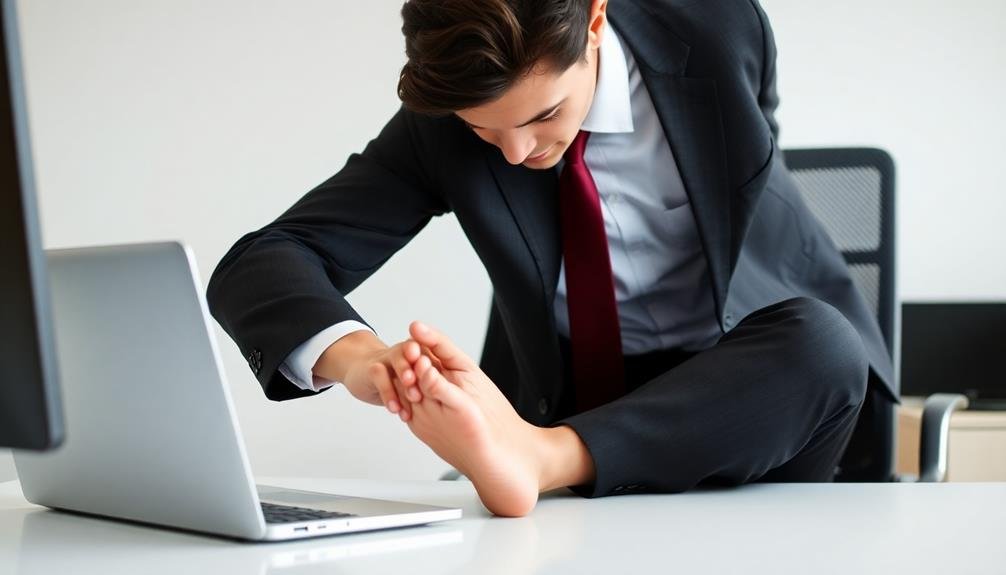
Office workers can find relief from back tension with the seated forward fold. This simple yet effective pose helps stretch your spine, hamstrings, and lower back muscles.
To perform it, start by sitting at the edge of your chair with your feet flat on the floor, hip-width apart. Take a deep breath in, and as you exhale, slowly bend forward from your hips. Let your upper body hang down between your legs, allowing your head and neck to relax completely.
You'll feel a gentle stretch along your spine and the back of your legs. If you can't reach the floor, rest your hands on your shins or ankles. Hold this position for 5-10 deep breaths, focusing on lengthening your spine with each exhale. To increase the stretch, you can gently press your chest towards your thighs.
When you're ready to come up, place your hands on your thighs and slowly roll up, stacking one vertebra at a time. This pose not only relieves tension but also improves circulation and can help reduce headaches caused by prolonged sitting.
Practice the seated forward fold whenever you need a quick break to reset your posture and rejuvenate your body.
Leg Extensions and Ankle Rotations
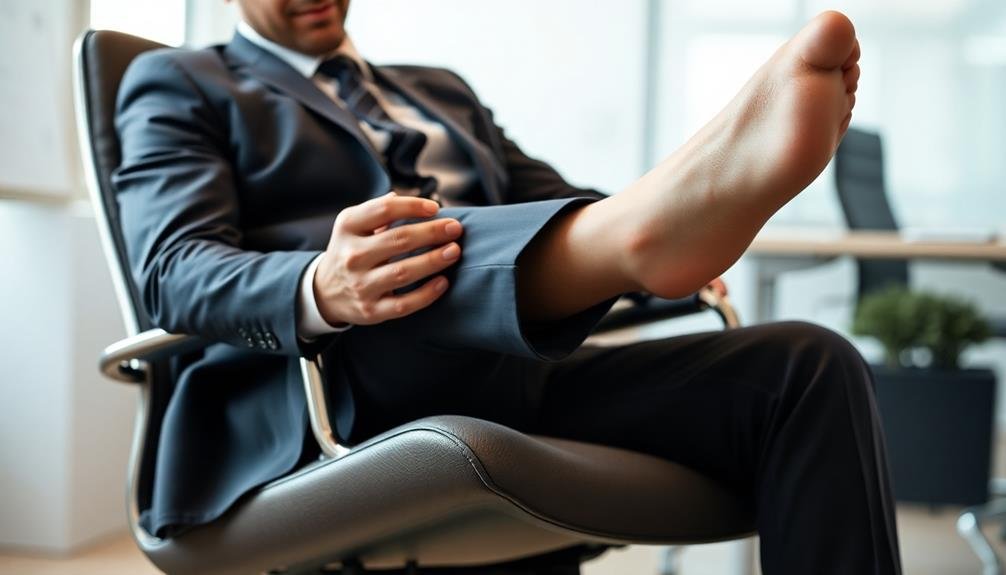
Restless legs and stiff ankles often plague office workers who sit for extended periods. To combat this discomfort, incorporate leg extensions and ankle rotations into your chair yoga routine.
Start by sitting up straight with your feet flat on the floor. Slowly extend one leg out in front of you, parallel to the ground. Hold for a few seconds, then lower it back down. Repeat with the other leg. Aim for 10-15 repetitions on each side.
For ankle rotations, lift one foot off the ground and rotate your ankle clockwise 5-10 times, then counterclockwise. Switch to the other foot and repeat. These exercises improve circulation, reduce stiffness, and help prevent swelling.
Incorporating leg extensions and ankle rotations into your daily routine offers several benefits:
- Increases blood flow to your lower extremities
- Reduces the risk of deep vein thrombosis
- Improves flexibility and range of motion in your legs and ankles
Remember to perform these exercises slowly and mindfully. If you experience any pain or discomfort, stop immediately and consult a healthcare professional.
Seated Mountain Pose

Seated Mountain Pose, a cornerstone of chair yoga, offers a simple yet effective way to improve posture and reduce tension while at your desk.
To begin, sit tall in your chair with your feet flat on the floor, hip-width apart. Align your ankles directly under your knees, creating a 90-degree angle. Rest your hands on your thighs, palms facing down.
Draw your shoulder blades down and back, opening your chest. Imagine a string pulling the crown of your head towards the ceiling, lengthening your spine. Tuck your chin slightly to maintain a neutral neck position. Engage your core muscles by gently pulling your navel towards your spine.
As you hold this pose, focus on your breath. Inhale deeply through your nose, feeling your ribcage expand. Exhale slowly through your mouth, releasing any tension. Stay in this position for 5-10 breaths, or longer if you're comfortable.
You can enhance the pose by raising your arms overhead, palms facing each other. This variation increases the stretch in your side body and shoulders. Remember to keep your shoulders relaxed and away from your ears.
Practice Seated Mountain Pose regularly throughout your workday to combat the effects of prolonged sitting and maintain better posture.
Chair Pigeon Pose
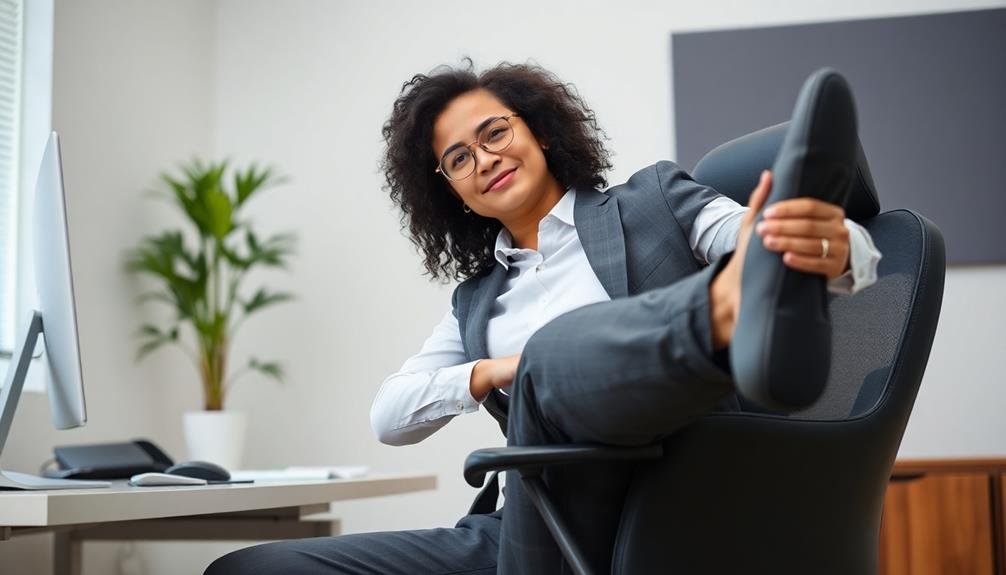
Stretching your hips and glutes can provide relief from the discomfort of prolonged sitting. The Chair Pigeon Pose is an excellent way to target these areas while remaining seated at your desk. To perform this pose, start by sitting up straight in your chair with both feet flat on the floor. Lift your right ankle and place it on your left thigh, just above the knee. Keep your right foot flexed to protect your knee. Gently lean forward, hinging at the hips, until you feel a stretch in your right hip and glute. Hold this position for 30 seconds to a minute, then switch sides.
As you practice the Chair Pigeon Pose, remember these key points:
- Maintain a straight spine throughout the stretch to maximize its effectiveness.
- Breathe deeply and slowly to help relax your muscles and increase the stretch.
- If you experience knee pain, adjust your foot position or reduce the intensity of the stretch.
This pose not only helps alleviate tension in your hips and glutes but also improves circulation in your lower body.
Wrist and Finger Stretches
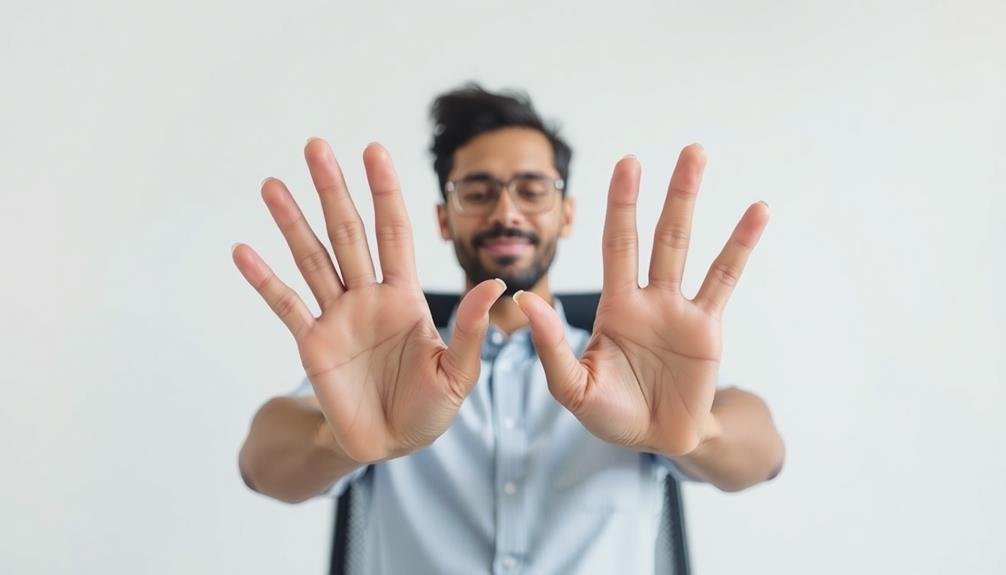
Many office workers experience tension and discomfort in their hands and wrists due to prolonged keyboard and mouse use. To alleviate this, you can perform simple wrist and finger stretches right at your desk.
Start by extending your arms in front of you, palms facing down. Gently bend your wrists, pointing your fingers towards the ceiling. Hold for 10 seconds, then point your fingers towards the floor. Repeat this sequence 3-5 times.
Next, make a fist with both hands, then slowly open them, spreading your fingers wide. Close your fists again and repeat 10 times.
For individual finger stretches, gently pull each finger back towards your wrist, holding for a few seconds.
To target your thumbs, make an "O" shape by touching your thumb to each fingertip, one at a time. For a deeper stretch, use your opposite hand to gently pull your thumb away from your palm.
Frequently Asked Questions
How Often Should Office Workers Practice Chair Yoga During the Workday?
You should practice chair yoga at least twice a day during your workday. Take short breaks every couple of hours to stretch and move. Even 5-10 minutes of chair yoga can help you relax and refocus.
Can Chair Yoga Help With Weight Loss or Calorie Burning?
Chair yoga can help with weight loss, but it's not a high-calorie burner. You'll primarily benefit from improved flexibility, reduced stress, and better posture. It's a gentle form of exercise that complements other weight loss efforts you're making.
Are There Any Chair Yoga Poses to Improve Posture?
Yes, there are several chair yoga poses to improve posture. You can try the seated mountain pose, cat-cow stretch, and seated twist. These poses help align your spine, strengthen your core, and increase flexibility in your back muscles.
What Equipment Is Needed for an Effective Chair Yoga Routine?
You don't need much for chair yoga. Just grab a sturdy chair and wear comfortable clothes. A yoga mat isn't necessary, but it can provide cushioning. You'll also want to have some water handy for hydration.
Can Chair Yoga Exercises Help Reduce the Risk of Carpal Tunnel Syndrome?
Yes, chair yoga can help reduce carpal tunnel risk. You'll strengthen and stretch your wrists, hands, and forearms. Practice gentle wrist rotations, finger stretches, and arm extensions regularly. It's a great way to combat repetitive strain injuries.
In Summary
You've now got a variety of chair yoga poses to help you unwind during your workday. Don't forget to practice these regularly to combat the stresses of office life. Even a few minutes of stretching can make a big difference in how you feel. Listen to your body, breathe deeply, and make these poses part of your daily routine. You'll soon notice improved flexibility, reduced tension, and a calmer mind.

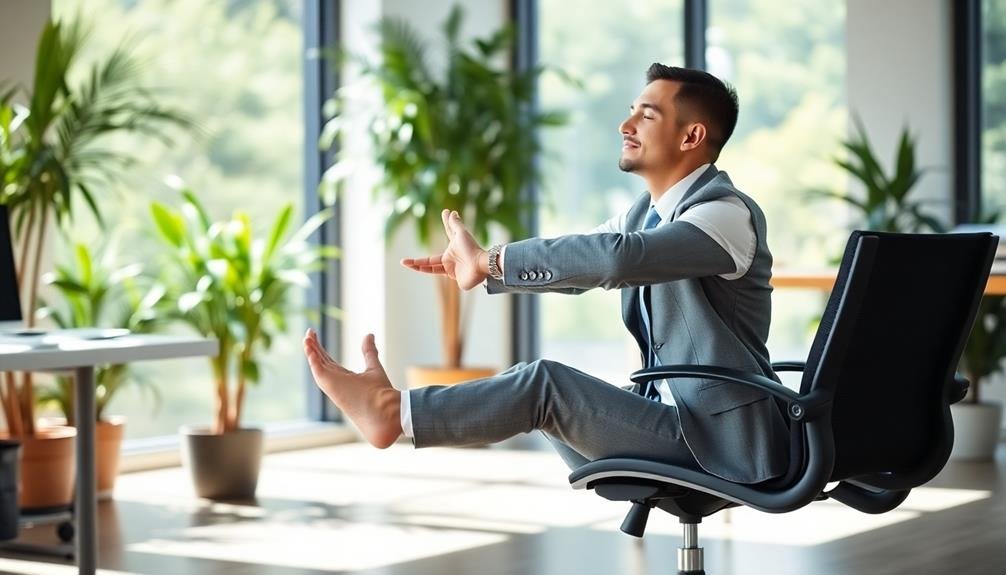



Leave a Reply